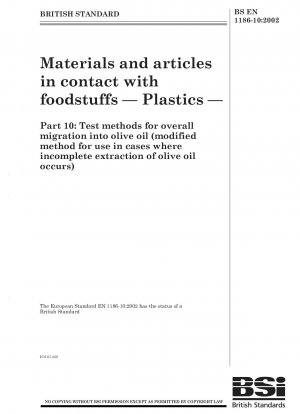BS EN 1186-10:2002
Materials and articles in contact with foodstuffs - Plastics - Test methods for overall migration into olive oil (modified method for use in cases where incomplete extraction of olive oil occurs)
- Standard No.
- BS EN 1186-10:2002
- Release Date
- 2002
- Published By
- British Standards Institution (BSI)
- Latest
- BS EN 1186-10:2002
- Replace
- DD ENV 1186-10-1994
- Scope
- This European Standard specifies test methods for the determination of the overall migration into fatty food simulants from plastics materials and articles, by total immersion of test specimens in a fatty food simulant at any temperatures above 5 °C up to and including 175 °C for selected times. When some plastics are tested by the methods in EN 1186-2, EN 1186-4, EN 1186-6, EN 1186-8, prEN 1186-12 and EN 1186-13, the soxhlet extraction process does not achieve complete recovery of the absorbed olive oil from the test specimens. In this method, the olive oil is released from the plastics test specimens by dissolving them in chloroform, toluene, xylene or tetrahydrofuran. This method is suitable for plastics when exposure to olive oil is by total immersion as described in EN 1186-2, in a cell, as described in EN 1186-4, in a pouch, as described in EN 1186-6, and by filling, as described in EN 1186-8 and to tests carried out at low and high temperature, as described in prEN 1186-12 and EN 1186-13. This is provided the plastics are soluble in chloroform, toluene, xylene or tetrahydrofuran and insoluble in methanol and that whenever prEN 1186-2 is referred to in this method the appropriate clause of the relevant part of EN 1186 is substituted. The method can also be suitable for plastics which are only partially soluble in chloroform, toluene, xylene or tetrahydrofuran and insoluble in methanol. NOTE 1 This test method has been written for use with the fatty food simulant, olive oil. The test method can also be used with appropriate modifications with 'other fatty food simulants' called simulant D - a synthetic mixture of triglycerides, sunflower oil and corn oil. These other fatty food simulants will produce different chromatograms for the simulant methyl esters to those of the methyl esters of olive oil. Select suitable chromatogram peaks of the methyl esters of the other fatty food simulants for the quantitative determination of the simulant extracted from the test specimens. NOTE 2 If it has been established that the overall migration into olive oil from the plastics cannot be determined by use of either this method or the methods described in EN 1186-2, EN 1186-4, EN 1186-6 and EN 1186-8 then the use of substitute tests should be considered, see clause 6 of EN 1186-1:2001.
BS EN 1186-10:2002 history
- 2002 BS EN 1186-10:2002 Materials and articles in contact with foodstuffs - Plastics - Test methods for overall migration into olive oil (modified method for use in cases where incomplete extraction of olive oil occurs)
BS EN 1186-10:2002 Materials and articles in contact with foodstuffs - Plastics - Test methods for overall migration into olive oil (modified method for use in cases where incomplete extraction of olive oil occurs) has been changed from DD ENV 1186-10-1994 Materials and Articles in Contact with Foodstuffs - Plastics - Part 10: Test Methods for Overall Migration into Olive Oil (Modified Method for Use in Cases Where Incomplete Extraction of Olive Oil Occurs).
